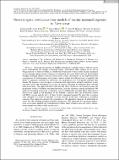Files in this item
Discrete-space continuous-time models of marine mammal exposure to Navy sonar
Item metadata
| dc.contributor.author | Jones-Todd, Charlotte M. | |
| dc.contributor.author | Pirotta, Enrico | |
| dc.contributor.author | Durban, John W. | |
| dc.contributor.author | Claridge, Diane E. | |
| dc.contributor.author | Baird, Robin W. | |
| dc.contributor.author | Falcone, Erin A. | |
| dc.contributor.author | Schorr, Gregory S. | |
| dc.contributor.author | Watwood, Stephanie | |
| dc.contributor.author | Thomas, Len | |
| dc.date.accessioned | 2021-11-22T12:30:01Z | |
| dc.date.available | 2021-11-22T12:30:01Z | |
| dc.date.issued | 2021-11-21 | |
| dc.identifier | 276359303 | |
| dc.identifier | 288d8180-7dc6-4470-a2ca-f6b3a509a60e | |
| dc.identifier | 85119529428 | |
| dc.identifier | 000720826800001 | |
| dc.identifier.citation | Jones-Todd , C M , Pirotta , E , Durban , J W , Claridge , D E , Baird , R W , Falcone , E A , Schorr , G S , Watwood , S & Thomas , L 2021 , ' Discrete-space continuous-time models of marine mammal exposure to Navy sonar ' , Ecological Applications , vol. Early View , e02475 . https://doi.org/10.1002/eap.2475 | en |
| dc.identifier.issn | 1051-0761 | |
| dc.identifier.other | RIS: urn:0B214EAF177562BC5665F1DDFE8BE650 | |
| dc.identifier.other | ORCID: /0000-0002-7436-067X/work/103865267 | |
| dc.identifier.other | ORCID: /0000-0003-3541-3676/work/106838539 | |
| dc.identifier.uri | https://hdl.handle.net/10023/24379 | |
| dc.description | This study was supported by Office of Naval Research (ONR) grant N00014- 16-1-2858: “PCoD+: Developing widely-applicable models of the population consequences of disturbance”. Funding support for tagging was provided by the U.S. Navy’s ONR and Living Marine542 Resources (LMR) program, the Chief of Naval Operations’ Energy and Environmental Readiness Division and the NOAA Fisheries Ocean Acoustics Program544 (see Joyce et al. (2020) for details). Hawai‘i field efforts were funded by the U.S. Navy (Pacific Fleet, LMR) and the National Marine Fisheries Service (Pacific Islands Fisheries Science Center). Field efforts were supported by grants from the U.S. Navy’s LMR and N45 programs. | en |
| dc.description.abstract | Assessing the patterns of wildlife attendance to specific areas is relevant across many fundamental and applied ecological studies, particularly when animals are at risk of being exposed to stressors within or outside the boundaries of those areas. Marine mammals are increasingly being exposed to human activities that may cause behavioral and physiological changes, including military exercises using active sonars. Assessment of the population-level consequences of anthropogenic disturbance requires robust and efficient tools to quantify the levels of aggregate exposure for individuals in a population over biologically relevant time frames. We propose a discrete-space, continuous-time approach to estimate individual transition rates across the boundaries of an area of interest, informed by telemetry data collected with uncertainty. The approach allows inferring the effect of stressors on transition rates, the progressive return to baseline movement patterns, and any difference among individuals. We apply the modeling framework to telemetry data from Blainville's beaked whale (Mesoplodon densirostris) tagged in the Bahamas at the Atlantic Undersea Test and Evaluation Center (AUTEC), an area used by the U.S. Navy for fleet readiness training. We show that transition rates changed as a result of exposure to sonar exercises in the area, reflecting an avoidance response. Our approach supports the assessment of the aggregate exposure of individuals to sonar and the resulting population-level consequences. The approach has potential applications across many applied and fundamental problems where telemetry data are used to characterize animal occurrence within specific areas. | |
| dc.format.extent | 13 | |
| dc.format.extent | 2191044 | |
| dc.language.iso | eng | |
| dc.relation.ispartof | Ecological Applications | en |
| dc.subject | Aggregate exposure | en |
| dc.subject | Area attendance | en |
| dc.subject | Beaked whales | en |
| dc.subject | Individual-level random effects | en |
| dc.subject | Sonar disturbance | en |
| dc.subject | Template Model Builder | en |
| dc.subject | Transition probability | en |
| dc.subject | GC Oceanography | en |
| dc.subject | QA Mathematics | en |
| dc.subject | QH301 Biology | en |
| dc.subject | DAS | en |
| dc.subject | SDG 14 - Life Below Water | en |
| dc.subject.lcc | GC | en |
| dc.subject.lcc | QA | en |
| dc.subject.lcc | QH301 | en |
| dc.title | Discrete-space continuous-time models of marine mammal exposure to Navy sonar | en |
| dc.type | Journal article | en |
| dc.contributor.institution | University of St Andrews. School of Biology | en |
| dc.contributor.institution | University of St Andrews. Statistics | en |
| dc.contributor.institution | University of St Andrews. Centre for Research into Ecological & Environmental Modelling | en |
| dc.contributor.institution | University of St Andrews. Marine Alliance for Science & Technology Scotland | en |
| dc.identifier.doi | 10.1002/eap.2475 | |
| dc.description.status | Peer reviewed | en |
This item appears in the following Collection(s)
Items in the St Andrews Research Repository are protected by copyright, with all rights reserved, unless otherwise indicated.

